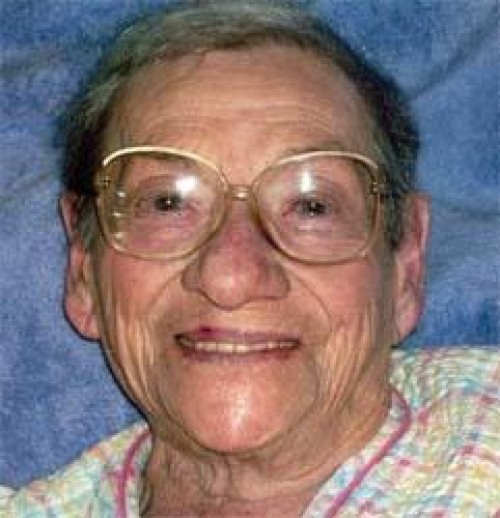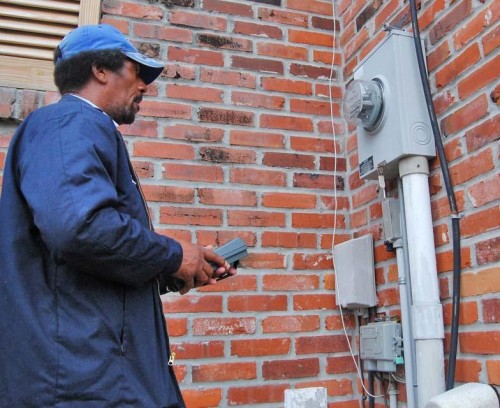Houma Navigation Canal bridge to close
January 12, 2010
Hilda Guidry Curole
January 14, 2010The job of a meter reader is more than it appears to the naked eye. With recent bursts of cold weather and a downed economy, the job has gotten even harder for employees of area electricity providers and those paying the bills.
Outfitted in a dark blue uniform and baseball cap, Jerry White, a meter reader for the city of Houma says, “We usually see people’s bills go up this time of year.”
Just like any other day, it starts at 7 a.m., whether rain or shine, there’s work to be done.
In a small corner office just off Gabasse Street, a group of five gets ready to head into the trenches by planning their routes. A cluster of reading devices and walky-talkies – the weapons of choice – litter a white table directly inside the door.
By 7:10 a.m., the group is marching toward the exit, each armed with a reading device and a 3-foot-long stick with a bright yellow tennis ball attached to the end; a useful contraption designed to keep pesky dogs away by entertaining them.
While the day appears to mirror the norm, a cold front is on its way.
The job continues
As January continues to push forward, colder temperatures will make an inevitable appearance, increasing the amount of energy people use to heat their homes and the amount of manpower needed to ensure meters are read as accurately as possible.
Walking from house to house, White adds, “…higher bills are rough on all of us.” If a meter reads high when compared to the customer’s usual consumption, employees are required to pull out the pen and paper and reread it after completing their route.
Adjustments are necessary if the amount of energy consumption has been entered incorrectly.
The normal shift runs from about 7 a.m. to 4 p.m. but can wan into the evening hours depending on the amount of rereads and corrections.
Alongside the hours, White, who is also a two-year veteran of the trade, says he usually walks between four and five miles a day. “It sure keeps me in shape.”
At the age of 53, White continues to swiftly work his way through the maze of backyards, now fully illuminated by the sun’s rays. “I like being out here, working in the community,” says the reader, while lifting his device to the gray box hanging overhead.
“I can read about 300 meters a day.”
According to Ed Lawson, a customer service manager for the city of Houma, the electric company caters to about 20,000 customers. “It’s nothing we can’t handle,” claims Lawson.
But the biggest worry for some is increasing heat bills.
Lawson says they see about 500 delinquent shutoffs per month.
In light of those numbers, the manager adds, “During the holidays we try to help people out. We know that everyone’s working with a little less cash this time of year.”
However, many times people’s problems far exceed the type of help the city can provide. When it’s all said and done, “…this is a business,” notes Lawson.
Philip Allison, spokesperson for Entergy Louisiana, said that, statewide, disconnects in November 2009 totaled 8,223, down from 9,403 in 2008. He attributes the drop to several factors including a decrease in fuel prices.
Since bills are issued for past periods of energy consumption, experts say it’s hard to tell whether frigid temperatures will play a part in higher bills or more disconnects.
On the other side of the spectrum, local outreach programs are starting to feel the pinch, fueled by a flood of people who need help paying their electric bills.
Although south Louisiana is far from the grasp of snowstorms hitting states in the northern part of the country, officials say the scurry to keep people warm could get worse.
Give life, give warmth
Kay Raymond, executive director of St. Mary Outreach, says, “I know with the heat that we’ve been using, I cringe even at my office. When it gets cold, even for just a few days, we’re going to see increases [in the heat bill].
“Seeing that, I know my clients are going to start coming in,” she adds. “I mean, we’re facing unemployment, people on fixed incomes, and now we’ve got the cold weather. So the bills are going to get higher.”
Aside from helping out with heat bills, the outreach has been providing things like life-sustaining medications and food to St. Mary residents since 1985.
According to Raymond, the outreach has extended a hand this year to an influx of people needing coats and jackets because of longer than normal cold spells.
Unlike some organizations, the outreach doesn’t base eligibility solely on income levels. “We try to catch the ones who normally fall through the cracks,” notes the director. “Some people might not be able to pay their bills because of an illness…” when normally they would have been making enough money.
Despite what some would call hard times, the outreach has still received a fair amount of personal donations, in addition to funds received by the St. Mary Parish Council and programs like Helping Hands, which also operates in Lafourche Parish.
“I have found that people have really dug deep into their pockets, knowing there are other people suffering right now,” says Raymond.
But with blustery winds beginning to dominate the forecast, the director notes that local organizations like hers will undoubtedly face struggles in efforts to keep pace with rising needs like staying warm.
Troubles on the horizon, possible
Melanie VanBuren, Terrebonne Parish’s housing and human services administrator, says that over the course of three days, their office has seen nearly 300 applications from Terrebonne residents seeking energy assistance through the Low Income Home Energy Assistance Program.
With a budget of about $250,000 a year, funds are likely to see extinction before the end of this month. “I really believe that once all our applications are entered into the system, that money will be gone,” adds VanBuren.
“Every year we go through the same thing,” she says.
In the months to come, VanBuren also expects an increase in the number of people seeking assistance – many of whom may be left in the cold because of shortfalls in funding.
And while the cold weather may be to blame, local electricity providers say that other factors are more dominant in determining the amount people can expect to pay for heat: fuel and transportation costs, natural disasters, jobless rates and economic growth in relation to income levels are to name a few.
Official documents show that electricity and natural gas rates are actually lower this month when compared to January 2009. But that hasn’t stopped the crowds from knocking on the doors of local outreaches and help organizations.
Jerry White, 53, reads a meter in a residential neighborhood in Houma. As temperatures in the area drop, energy consumption begins to rise. * Photo by MICHAEL DAVIS












